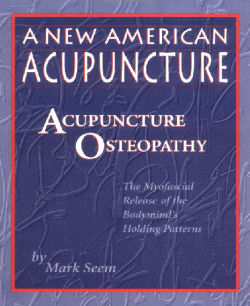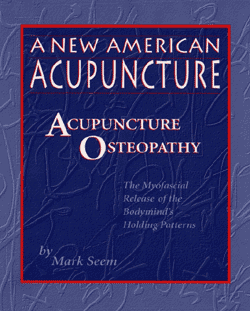Acupuncture and TCM Books
A New American Acupuncture : Acupuncture Osteopathy:
The Myofascial Release of the Bodymind's
by Mark Seem
DESCRIPTION: This book represents the fruit of many years of research into the use of acupuncture as a tool for releasing holding patterns in the bodymind as a way to restore functional/structural balance and to relieve chronic pain. Dr. Seem shares his clinical experience of how and why this style of acupuncture works and presents specific protocols for use in the clinic. This book is a valuable reference text for anyone whose practice focuses mainly on acupuncture.
Table of Contents
Part I: Treatment Principles
1 The Return of the Body & the Importance of Touch, 11
2 Tender Points Revisited, 19
3 Root & Branch Treatment Principles: Distal & Local Acupuncture, 35
4 Myofascial Chains, 57
5 Somatovisceral & Viscerosomatic Pain & Dysfunction: Organs, Meridians, or Both?, 61
Part II: Treatment Protocols
6 A Tender Point Acupuncture Protocol for Pain Management, 77
7 The Dorsal Zone, 85
8 The Lateral Zone, 105
9 The Ventral Zone, 119
10 Acupuncture & Dry-needling, 135
11 Acupuncture Tender Point Therapy for Acute, Recurrent, & Chronic Pain, 141
Index, 151
Introduction
The Point of Acupuncture In Traditional Chinese Medicine or TCM's attempt to standardize Chinese medicine into a unified system that could be taught in identical fashion to countless numbers of students throughout the People's Republic of China's new Institutes of Traditional Chinese Medicine starting in the early 1960s, the mainland Chinese also standardized the locations of the acupuncture points in Western scientific, anatomical terms. Rather than the vague classical definitions, such as, “in a depression a hand's breadth below the outside of the knee’, Chinese TCM acupuncturists with an eye to the West sought something far more rigorous. In carrying out this standardization, acupuncture points were laid over the various anatomical images of muscles, nerves, blood vessels, and bones from their Western atlases. The charts which made their way to the West showed beautifully rendered images of the nervous system, the circulatory system, the muscular system, and the skeletal system with the acupuncture points drawn in precisely. At the same time, TCM acupuncture textbooks translated from Chinese leaned and still lean heavily toward the skeletal image with their precise descriptions of bones, tendons, and joints. Most TCM textbook locations thus recharted the vaguely defined classical point locations onto this seemingly more precise and scientifically sound backdrop.
In looking at classical Chinese diagrams of point location, however, one sees no such attempts at anatomical precision. No muscles are drawn in, not even shadings to indicate key muscular configurations and bony protuberances. All that appears in these totally flat drawings is a general pathway of a specific meridian with a specific number of points drawn in for each. It would seem that these early charts were meant, along with the vague descriptions of point location that accompanied them in the early texts, as a mere guide to enable the student to learn the basic pathways, the number of points, and the general point locations for each meridian. Then the student was expected to find a teacher who would demonstrate how to palpate the surface of the body, feeling along meridian pathways until something was felt under the fingertips that indicated that the actual point lay precisely there. This early, oral tradition required a close teacher-student relationship and assumed that much that is essential to the successful practice of acupuncture had to be felt directly and not just memorized from diagrams and books.
This method of experience-based point location changed dramatically once the standard Western anatomical locations were established in contemporary TCM textbooks. Point locations in such books are now given as, “at the midpoint of the transverse crease of the popliteal fossa, between the tendons of m. biceps femoris and m.semitendinosus,’ or, “1.5 cun lateral to the lower border of the spinous process of the 3rd thoracic vertebra.’1 While these descriptions appear very precise, they do not state what muscle the acupuncture needle actually penetrates or is imbedded in. For instance, in the first case above, the needle is imbedded in the plantaris muscle, the actual site of Bl 40; while in the second case, the needle is embedded in the superficial paraspinal, erector spinae muscles, the actual muscular site of the back shu points like Bl 13 above. Opting primarily for a skeletal image of point location, contemporary TCM leads its students of acupuncture away from a knowledge of the body that has to be touched to be known toward one that can simply be measured. In a now seemingly scientific fashion, acupuncture students have become skilled at rapid location of points measured against exact textbook locations.
 A New American Acupuncture
A New American Acupuncture